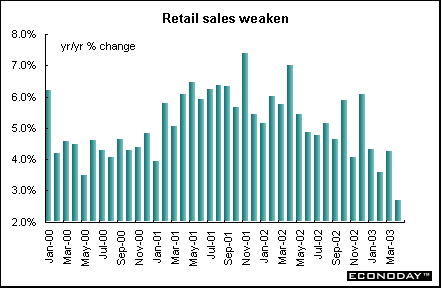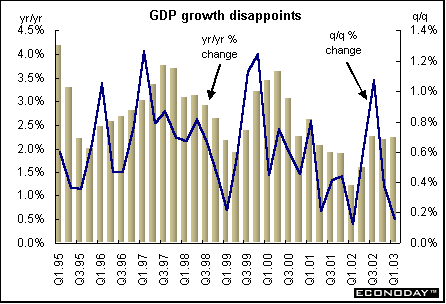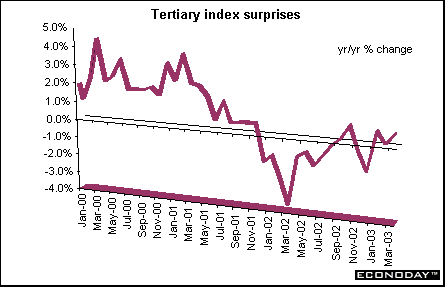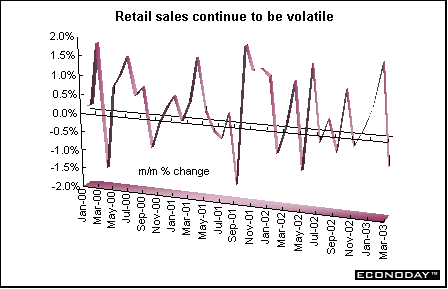
Indicator scoreboard
EMU - March merchandise trade surplus with the rest of the world shrank to €1.6 billion from the surplus of €11.0 billion a year earlier. The surplus was also down from February's €5.2 billion. The data suggest that the euro's appreciation and weak world growth are starting to hit the EMU trade sector. Exports fell 6.3 percent while imports climbed 4.3 percent when compared with last year.

March seasonally adjusted industrial output sank 1.2 percent and 0.3 percent when compared with last year. Industrial output fell in most countries. All sectors were down with the exception of intermediate goods, which were unchanged on the month.

Germany - April seasonally adjusted producer price index dropped 0.6 percent but was up 1.6 percent when compared with last year. The decline was due to lower energy prices. Energy prices dropped 1.5 percent but are still up 5.1 percent over last year. Excluding energy, the PPI was unchanged and up 0.7 percent on the year.

First quarter real seasonally adjusted gross domestic product slipped 0.2 percent and inched up 0.2 percent when compared with last year. Gross fixed capital investment sank 1.7 percent with construction investment down by 3.3 percent and other investment down by 1.2 percent. Capital investment climbed 0.3 percent. All other GDP categories rose. Private consumption was up 0.6 percent while government consumption rose 0.1 percent.

March seasonally adjusted industrial production was revised up sharply to a decline of only 0.1 percent from the originally reported 1.1 percent decline. Industrial production excluding construction - the figure that Eurostat uses when calculating eurozone industrial output - was revised to a drop of 0.7 percent from an initial decline of 1.9 percent. Manufacturing output was revised to a 0.7 percent decline from the original 1.7 percent drop.

France - First quarter seasonally and workday-adjusted gross domestic product increased by 0.3 percent after slipping 0.1 percent in the fourth quarter of 2002. GDP was 1.0 percent higher than the first quarter of 2002. The increase was attributed to stronger private consumption, an unexpected rebound in business investment and a slower drawdown on inventories. However, exports dropped while imports jumped. The increase was in contrast to the first quarter declines in Germany, Italy and the Netherlands.

April seasonally and calendar adjusted consumer spending on manufactured goods was unchanged but up 1.4 percent when compared with last year. Household durable spending rebounded 1.2 percent after sinking 0.6 percent in March. Excluding autos, auto parts and drugs, consumer spending was up 0.1 percent and 3.0 percent higher on the year.

Italy - March industrial orders plunged 9.0 percent when compared with last year. Domestic orders sank 8.1 percent while foreign order plummeted 11.1 percent. March seasonally adjusted orders data, which are not closely followed by most analysts, declined 3.2 percent on the month. Domestic orders were down 2.9 percent while foreign orders sank 4.0 percent. Eight of 10 product sectors declined.
March retail sales were down 0.2 percent but up 0.8 percent when compared with last year. Sales were hurt in part by the timing of the Easter holidays which occurred in March last year. At the beginning of 2003, the weighting for large retail outlets was increased to 38.4 percent of the total basket from 16.3 percent.
Britain - April retail price index (RPI) jumped 0.7 percent and was up 3.1 percent when compared with last year. The retail price index excluding mortgage interest payments (RPIX) also climbed 0.7 percent and rose 3.0 percent on the year. April was the sixth successive month in which the RPIX was above the Bank of England's 2.5 percent inflation target. The largest upward impact on inflation came from housing costs, mainly due to a rise in an annual housing tax.

April retail sales increased 0.3 percent and were up 2.7 percent on the year, the weakest annual increase since May 1999. Growth in sales during April was led by food sales, which rose by 0.8 percent. Non-food sales volumes were flat on the month. Household goods stores posted a 1.5 percent monthly increase.

First quarter gross domestic product crept up 0.2 percent and climbed 2.2 percent when compared with last year. The slowdown in growth was led by a sharp deceleration in the rate of growth of household spending which increased just 0.4 percent to 3.4 percent on the year, the weakest quarterly rise since the third quarter of 1997. General government spending rose 1.4 percent and 1.5 percent above levels a year earlier. Investment inched down 0.1 percent but was up 1.0 percent on the year.

Asia
Japan - April seasonally adjusted merchandise trade surplus rose to ¥803.5 billion ($6.8 billion) from ¥646 billion in March. From a year earlier, the surplus rose 1.6 percent to ¥840.4 billion. Lower oil prices drove imports down 3.8 percent as exports rose 0.4 percent.

March tertiary index climbed 0.5 percent and 0.7 percent when compared with last year. The index was lifted by demand for utilities, restaurants and real estate services. The tertiary index reflects activity in six industries: utilities, transport and telecommunications, wholesale and retail, finance and insurance, real estate and services. Demand for air travel and other transportation fell as SARS prompts consumers to stay at home. The all industry index rose 0.7 percent and 1 percent on the year. The all industry index is used as a proxy for gross domestic product because it adds industrial production, construction, agriculture and government spending to the tertiary index.

Americas
Canada - March retail sales fell 0.7 percent on lower consumer spending in the automotive and general merchandise sectors. The automotive sector dropped 2.3 percent and general merchandise sales were down 1.3 percent. Four of the seven retail sectors increased. When compared with last year, retail sales are up a robust 4.7 percent. Retail sales excluding motor and recreational vehicle dealers were unchanged on the month and up 6.7 percent on the year.

April consumer price index dropped 0.7 percent but was up 3.0 percent when compared with last year. Weaker gasoline prices mainly caused both the monthly and annual decreases. Another factor was a drop in electricity prices in Ontario. Core CPI, which excludes food and energy, was unchanged on the month but up 3.2 percent on the year. Gasoline prices sank 9.0 percent on the month while fuel oil prices plummeted 18.0 percent. On a seasonally adjusted basis, the CPI fell 0.7 percent but was up 3.0 percent on the year. The Bank of Canada bases its policy actions on a core measure of the CPI excluding eight volatile components. On this basis, the CPI was up 2.1 percent on the year, well within the Bank's target range of 1 to 3 percent.



Last Week's Highlights • Global
Stock Market Indexes • Recap of Global Markets
• Currencies • Indicator
Scoreboard

The Bottom Line •
Looking Ahead
|